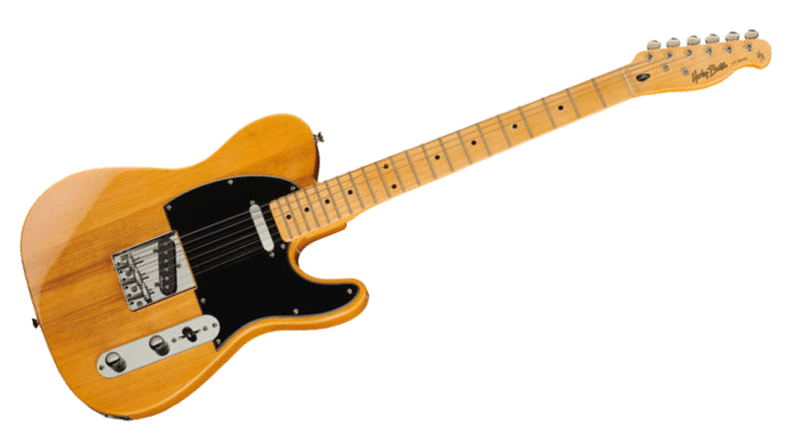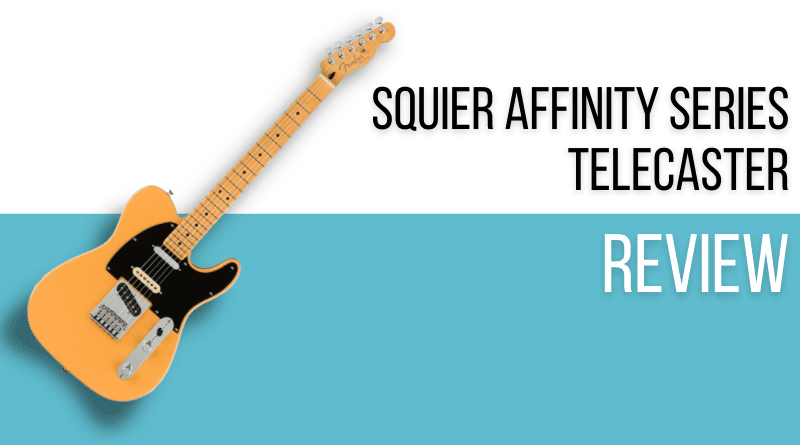The Telecaster is one of the most iconic guitar models in history. Introduced in 1951 by Leo Fender, the Telecaster has been widely used in a plethora of styles. Country and Rock are where the Tele feels most at home, but even renowned jazz and pop players have relied heavily on this solid-body guitar.
As one of the most popular electric guitar models, Telecaster-type guitars are produced by many brands. These run the gamut from boutique company versions for the discerning player that can afford expensive models, all the way to mass-produced inexpensive Tele models.
The Squier Affinity Series Telecaster belongs to the latter. Squier has been making affordable versions of Fender guitars for decades. As a matter of fact, Squier has been under the Fender company umbrella for decades now. In this KillerGuitarRigs Review, we take a look at one of the most popular Tele models in the lineup, the Affinity Series Telecaster.
This guitar will cost you less than three hundred dollars, which is quite a low price for any guitar, let alone a Tele. Let’s take a look.
Read more about our review process.
Contents
Who is This For?
The Squier Affinity Series Telecaster is for the beginner who has a clear preference for the Tele. You get a guitar that looks and sounds like a Telecaster, at a very affordable price.
If affordability is your top priority and you like Telecasters, the Squier Affinity Series Telecaster is a good choice.
Appearance/Features/Controls
The Squier Affinity Series Telecaster reviewed here is a Butterscotch Blonde with a maple fingerboard.
This guitar comes in three other combinations of color and fingerboard material: Three color sunburst with maple fingerboard, Lake Placid Blue with Indian laurel fingerboard, and Arctic White with Indian laurel fingerboard. Additionally, there is a left-handed option that is Butterscotch Blonde with a maple fingerboard.
The body on this Tele is made of poplar with a Gloss Polyurethane. As you’d expect, poplar is not among the best wood choices for a guitar body, but a necessary compromise on such an affordable instrument.
Squier did a good job on the neck, as it kept it close to the Fender tradition. As a result, the neck is a C-shape made of maple with a 9.5-inch radius and 21 medium jumbo frets, and the familiar Fender 25.5-inch scale length.
The radius of this neck is smaller than on most Telecasters. At just 9.5 inches, it can offer greater comfort for smaller hands. This is a great feature to have if you are interested in an electric guitar for a child, or just starting out. Simply said, you won’t have to move and stretch your fingers as much.
In true Telecaster fashion, this Squier electric guitar is equipped with two vintage-style Fender ceramic single-coil pickups. As expected, it comes with a 3-way toggle pickup switch, a master volume knob, and a tone knob to dial in your sound.
Performance/Sound
The first thing we noticed when we picked up the Squier Affinity Series Telecaster is how much lighter it is than regular Telecasters (even compared to many Tele copies). This is due to the use of poplar wood on the body.
As mentioned earlier, using poplar is a compromise that Squier had to make to maintain the low price of this instrument.
As we plugged into our Deluxe Reverb Fender amp, the first thing that jumped out is that the body is not as resonant as on a medium-priced Fender Telecaster. However, it is still a good choice for the money.
We started out on the neck position, on clean. While playing a few country licks it was apparent that the sound was indeed a Tele sound. The tone we got was in the vicinity of the crispness and bite that Teles are known for, which is an accomplishment for an instrument this cheap.
Moving on to some distortion via our Tube Screamer pedal, we kept the bridge pickup engaged while playing some Keith Richards-inspired Stones riffs. The sound was undoubtedly Telecaster, with good sustain and punch for a beginner instrument.
Switching to the neck pickup, we turned off the distortion to try out some jazz licks. Once again, this Squier Tele responded well, and we got a bit carried away playing some standards.
The neck felt good for a starter guitar. Although the reduced radius felt a bit constraining for bends and extended voicings, it can really be a positive feature on the hands of an inexperienced player. This is because it allows you to not have to stretch as far to get to the places you need to be.
We really appreciated the maple neck, as it kept us close to the way a Tele responds and feels. As far as the tuning and intonation, the Squier Affinity Series Telecaster did a good job on both fronts.
As you make progress, it is a given that you will outgrow this guitar. But we all have to start somewhere, and this Squier Tele offers sound and playability that add up to a nice starting point.
Other Guitars To Consider
Squier Paranormal Cabronita Telecaster Thinline

This guitar is a Semi-Hollowbody that features a poplar body, maple neck, maple fretboard, and 2 Jazzmaster Single-coil pickups. You get a warmer tone due to the cavity inside the body and a nice 2-color sunburst Tele that is a good buy for the money.
Harley Benton TE-52 NA Vintage Series

The Harley Benton TE-52 NA is one of the most affordable Telecaster copies on the market. This instrument is for very budget-conscious beginners that want a taste of a Telecaster. It features an ash body, a roasted maple neck and fingerboard, and Roswell single-coil pickups. In short, a Tele option for the severely cash-strapped beginner guitarist.
Final Thoughts
The Squier Affinity Series Telecaster is a good choice for a beginner that likes or has a curiosity for Telecasters. At less than three hundred dollars, this guitar plays and feels like a beginner Telecaster.
In other words, this Squier Telecaster is a nice starting point for anyone that is interested in playing a guitar with a Telecaster sound and feel at a very affordable price point.
Check out these other articles you might like:


